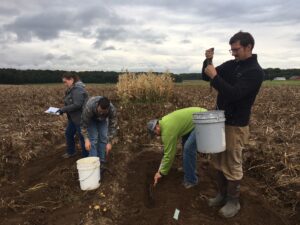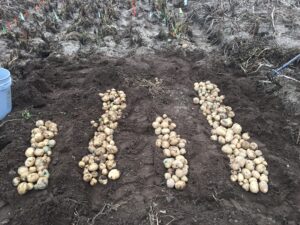Final report for FNC18-1113
Project Information
Sklarczyk Seed Farm is a small business and third generation farm operating out of Johannesburg, Michigan. We farm 700 acres of wheat, corn, and soybeans, as well as 50,000 square feet of greenhouse space. The hydroponic seed potato greenhouse operation is the focus of our diversified farm, producing over six million seed potatoes of nearly one hundred different varieties annually. Our on-site tissue culture lab produces plantlets for the greenhouse and a handful of growers. All minitubers produced by SSF are certified to be virus and disease free by the Michigan Seed Potato Association. We have received MAEAP verification for Farmstead, Cropping, and Greenhouse Systems. Currently, SSF employs twenty year-round and ten seasonal employees.
At this time, no industry standard exists for the pre-planting treatment of seed potato minitubers, despite potatoes being the third most important crop worldwide. The proper preparation of minitubers through Greensprouting (or chitting) procedures and optimal planting depth practices has the potential of doubling overall production of year one seed potatoes. We believe that through experimentation a low investment, high return standard procedure can be developed in order to maximize yield on the cultivated land already in use for potato production without the need of additional inputs from growers such as a larger farming footprint, increased pesticide applications, or additional man-hours during the busiest times of the year.
Greensprouting will be accomplished by removing minitubers from a 35° storage environment several weeks before planting, then placing them in indirect light at 70°and gently rotating every three days. Short, green sprouts will develop, indicating that the minitubers have broken dormancy and are ready to be planted. Control minitubers will receive similar treatment for only three days prior to planting. All minitubers will be planted in a randomized block design at 1.0, 1.5, 2.0, 2.5, 3.0, and 3.5 inches. Plant vitality, days to emergence and overall yield will be monitored and analyzed.
1. Identify a sustainable seed potato pre-planting treatment procedure that will be possible to implement on a large scale within the potato industry.
2. Perform a proof-of-concept field trial experiment to evaluate the effectiveness of the pre-planting treatment on increasing seed potato yield at a variety of planting depths.
3. Develop an industry engagement program to share experimental findings through the use of social media, field days, poster publication, and conference presentation.
Research
Field Trials were conducted during the 2018 growing season on cultivated land in Michigan. Management of the test plots and the surrounding potato fields were overseen by an on-site farm manager, while experimental design and data collection were performed by Sklarczyk Seed Farm.
First generation potato seed was planted in the field surrounding the plots to prevent alteration of field crop management practices, reduce variables, and generate the maximum amount of usable data for early generation minituber partners and growers.
Test plots were set up utilizing randomized block designs to minimize the effects of nuisance factors at the field setting on the data set. A minimum of three replicated plots for each variable being tested were set up, with a minimum of ten samples for each variable within the plot being monitored for the duration of the experiment.

Overall yield, number of days to plant emergence from the soil, and plant vitality were monitored for each of the tested factors. Yield data was collected ninety-nine days after planting by performing a ten foot dig and recording total mass. Plant emergence was monitored daily for twenty-eight days following planting. Plant vitality was measured for all plots seventy days after planting.

Our experiments found that Greensprouting results in higher tuber number, larger mass, and greater overall yield of up to 200% when compared to non-treated material planted in similar conditions. Regardless of the depth at which the seed was planted, Greensprouting resulted in greater yields.
Educational & Outreach Activities
Participation Summary:
Project results were communicated to peer farmers and the public through farm visits, field days, conference poster presentation, and further outreach at industry events and conferences utilizing Power Point presentations, posters, and flyers.
Greensprouting-2018-GL-Expo-Poster
Greatest interest was generated through farm visits, both to the testing site and by the project team to farmers interested in the practical application of the experiment to their own farm. Additionally, meetings and personal presentations during conferences and industry events generated massive interest and support for continued research into the effects of Greensprouting and seed-piece age on yields.
In the future, we plan to utilize our new website in order to reach more farmers interested in altering their practices to sustainably increase yields, as well as continue farm visits and field research to generate information that can be useful under diverse growing conditions. In 2019 we look forward to working with two new partners, Enander Farms and Walther Farms, to generate useful data and make a greater impact on the potato industry.
Learning Outcomes
- Regardless of on-farm planting practices (depth, field preparation etc.), Greensprouting potato seed minitubers has the potential to increase overall harvested yield by 2X.
- Additional trials in a variety of settings and climates are necessary to prove the efficacy of Greensprouting on a large, global, scale.
- On-farm research has the potential to increase sustainability and lead to increases in revenue across the industry.